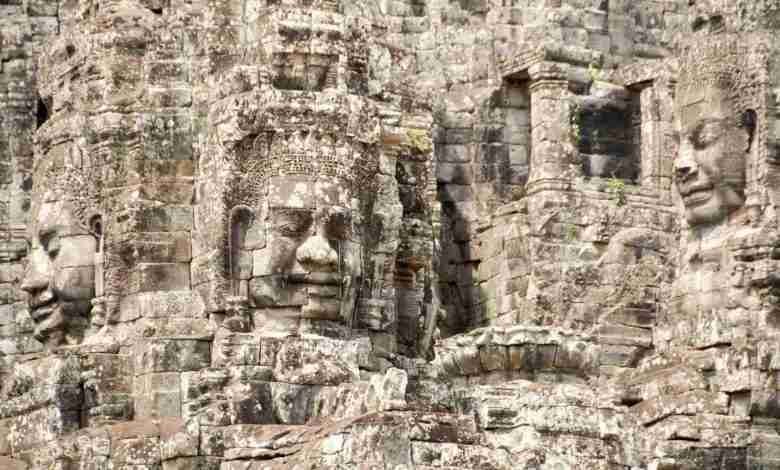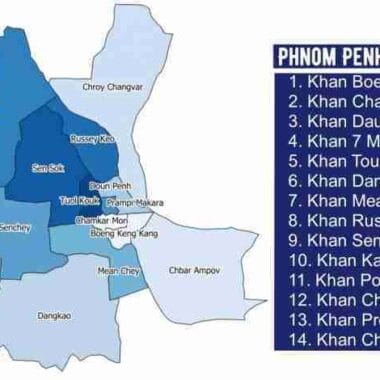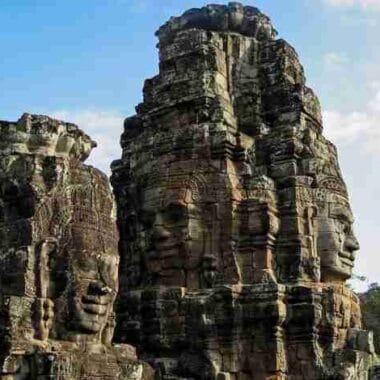Cambodia History: No one knows exactly how long people have lived in what is now Cambodia. Radiocarbon dating from a cave in northwestern Cambodia confirmed the presence that people using stone tools as early as 4000 BC. The first Cambodians likely arrived long before either of these dates.
Funan Kingdom (1st century – 550)
By the beginning of the 1st century AD, Chinese writers referred to a kingdom in Cambodia they called Funan which located on the Mekong Delta that flourished from the 1st century to the 6th century. Among the findings are excavations of a port city Oc-Eo in what is now southern Vietnam, another important city near the present-day village of Angkor Borei in Cambodia. These kingdoms already owed much to Indian culture, which provided alphabets, art forms, architectural styles, religions (Hinduism and Buddhism), and a stratified class system.
Chenla Kingdom (6th century – 802)
Chenla or Zhenla is the Chinese designation for the successor of the Kingdom of Funan that existed from around the late sixth to the early ninth century in Indochina. The name was still used in the 13th century by the Chinese author and it appears on the Mao Kun map in China.
The peak of the Chenla kingdom was reached under King Ishavarman’s reign, who conquered Funan during 612 and 628. After the death of king Jayavarman I in 681 A.D the kingdom which led to internal unrest and in the 8th century rivalry split the kingdom in two parts: Upper Chenla, which consisted of southern Laos and the northern territories bordering Tonle Sap, and Lower Chenla (water Chenla) which consisted of the eastern territories of Tonle Sap and the coastal territories.
Khmer Empire (802–1431) Angkor Era
The Khmer empire was a powerful state in South East Asia. It started in 802 AD and lasted until the 15th century. At its peak, the empire controlled much of what today is Cambodia, Thailand, Laos, and southern Vietnam. The capital of the Khmer empire, Angkor, was the largest urban city in history prior to the industrial revolution and supported up to one million people.
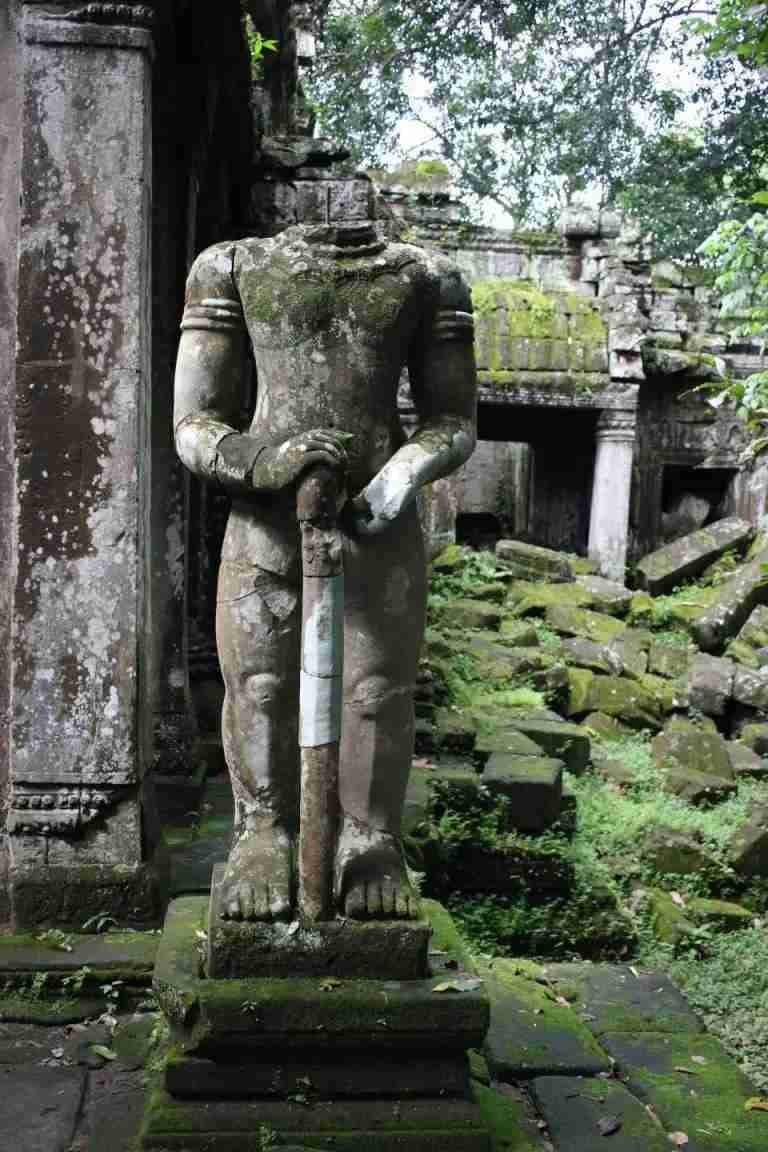
The success of the empire leaving a legacy of architectural masterpieces in the world, filling the landscape with monumental temples, huge reservoirs and canals, bridges and road. The most stunning temple, Angkor Wat, is a microcosm of the Hindu universe and defies imagination as the world’s largest religious complex. Its construction took some 30 years and was started by one of the greatest kings, Suryavarman II, around 1122 CE.
The empire’s greatest king was Jayavarman VII (r. 1181 CE – 1215 CE). He defeated the Chams and undertook the largest construction programme, he also known as the builder king. The scale of his construction projects was unprecedented: building not only Angkor Thom complex – a city within a city in Angkor, but roads, bridges, rest-houses, a hundred hospitals and monuments. After his death the empire began to decline and was severely undermined by Thai invasions in the 14th century. Battles continued for another century until the final siege in 1431 that brought the abandonment of Angkor and the end of the Angkor civilization.
Cambodia Dark Age (15th century to 1863)
Longvek was the ancient capital of Cambodia during the Dark ages of Cambodia, also called the Middle Period, refers to the historical era from the early 15th century to 1863. As reliable sources (for the 15th and 16th centuries, in particular) are very rare, a defensible and conclusive explanation that relates to concrete events that manifest the decline of the Khmer Empire.

During the Dark ages period, there is no stone epigraphy in temples, which had been the primary source for Khmer history. Recording of the royal Chronology discontinues with King Jayavarman IX, who reigned from 1327 to 1336. There exists not a single contemporary record of even a king’s name for over 200 years. There is no temple maintenance work, no temple construction, all architecture had come to a standstill after Jayavarnam VII’s reign.
The only sources for Cambodia’s 15 century are from external sources, the Chinese Ming Shilu annals, the earliest Royal Chronicle of Ayutthaya and the European explorers and adventurers.
During the 17th and 18th century, Siamese and Vietnamese dominance power as the Khmer monarch’s authority decreased to the state of a vassal. Both powers alternately demanded subservience and tribute from the Cambodian court. In the early 19th century with dynasties in Vietnam and Siam firmly established, Cambodia was placed under joint suzerainty, having lost its national sovereignty. To save Cambodia from being incorporated into Vietnam and Siam, King Ang Duong agreed to colonial France’s offers of protection, which took effect with King Norodom Prohmbarirak signing and officially recognizing the French protectorate on 11 August 1863.
French colonial period (1863–1953)
During the 19th century, the Kingdom of Siam had annexed Cambodia western provinces, including Angkor while the Vietnamese had influenced the eastern part of the country. Since then Cambodia kingdom became a battlefield between the two major power, Vietnamese and Siam, fought to take control over the weaken kingdom.
To save Cambodia, in August 1863 King Norodom Prohmbarirak signing and officially recognizing with the French placing the kingdom under the protection of France. The original treaty left Cambodian sovereignty intact, but by the end of the century the king’s authority no longer existed outside the palace. The French Protectorate of Cambodia lasted nearly 100 years. Cambodia gained its independence back on 9 November 1953.
Under the French protectorate allowed the Cambodia no opportunities and failed to educate Cambodian people. There was only one high school in the kingdom, and no university. The judiciary system was very poor, no sophisticated legal system, and almost no local lawyers. However, probably the positive made by the French was the fact that Cambodia survived to become an independent state, and was not absorbed by its neighbors. One of the few highlights, the French success in getting back northwestern provinces of Batdambang and Siemreab to Cambodia from Thailand in a new treaty in 1907.
Japanese occupation (April 1941-August 1945)
After King Monivong died in April 1941 and the French placed the obscure Prince Sihanouk on the throne as king. The 1940–41 Franco-Thai War left the French Indochinese colonial authorities in a position of weakness. Meanwhile, the Thai government took advantage of the weakened position of France, and invaded Cambodia’s western province of Batdambang, Siemreab, and parts of Kampong Thum and Stoeng Treng and nearly half a million citizens.
On March 9, 1945, Japanese forces in Indochina, including those in Cambodia, overthrew the French colonial administration. They encouraged indigenous rulers to proclaim independence. The young king Norodom Sihanouk proclaimed an independent Kingdom of Kampuchea, following a formal request by the Japanese. On the same year, the Japanese occupation of Cambodia ended with the official surrender of Japan in August 1945. The French were able to reimpose the colonial administration in Phnom Penh in October the same year.
Campaign for independence
In June 1952, Sihanouk assumed control of the government as prime minister after he announced the dismissal of dismissal of his cabinet, suspended the constitution and he dissolved the National Assembly and proclaimed martial law in January 1953. In March 1953, he went to France to persuade the French government to grant him a complete independence but the trip appeared to be a failure. On his way home by way of the United States, Canada, and Japan, Sihanouk publicized Cambodia through the media.
He left Phnom Penh in June to go to Thailand for self-imposed exile and would not return until the French gave assurances that full independence would be granted. Unwelcome in Thailand, he returned to his royal villa near the ruins of Angkor in Siemreab Province. On 3 July 1953, French declared itself ready to grant full independence to the three states of Cambodia, Vietnam, and Laos. King Sihanouk, now a hero in the eyes of his people, returned to Phnom Penh and independence day was celebrated on 9 November 1953.
Modern State (King Norodom Sihanouk)
Sihanouk put his nation on a modern footing in the 1960s after he abdicated the throne in 1955, especially bolstering the education system, but his Buddhist socialist agenda did poorly and produced economic stagnation. He is great Cambodian leader whose remarkable skills of political adaptation personified for the kingdom. The Sangkum (People’s Socialist Community) led by Sihanouk won all the seats in the national elections of 1955, benefiting from Sihanouk’s popularity and from police brutality at many polling stations.
In the late 1950s the Cold War intensified in Asia. The USSR supported the Vietnamese Communists, while the United States opposed them, and China wanted to contain Vietnam for security reasons. Each of the foreign powers hoped that Cambodian support would bolster its position in the region. Sihanouk pursued a policy of neutrality that drew substantial economic aid from the competing countries.
In 1965, however, Sihanouk broke off diplomatic relations with the United States. At the same time, he allowed North Vietnamese Communists, then fighting the Vietnam War against the United States and the South Vietnamese in southern Vietnam, to set up bases on Cambodian soil. As the economy became unstable, Cambodia became difficult to govern single-handedly. In need of economic and military aid, Sihanouk renewed diplomatic relations with the United States. Shortly thereafter, in 1969, U.S. president Richard Nixon authorized a bombing campaign against Cambodia in an effort to destroy Vietnamese Communist sanctuaries there.
Khmer Republic
In March 1970 Cambodia’s legislature, the National Assembly, deposed Sihanouk while he was abroad. The conservative forces behind the coup were pro-Western and anti-Vietnamese. General Lon Nol, the country’s prime minister, assumed power and sent his poorly equipped army to fight the North Vietnamese Communist forces encamped in border areas
In April U.S. and South Vietnamese troops invaded Cambodia, searching for North Vietnamese, who moved deeper into Cambodia. Over the next year, North Vietnamese troops destroyed the offensive capacity of Lon Nol’s army. By that time, Chinese and North Vietnamese leaders had persuaded the prince to establish a government in exile, allied with North Vietnam and dominated by the CPK, whom Sihanouk referred to as the Khmer Rouge.
Democratic Kampuchea
The Khmer Rouge ousted General Lon Nol in 1975. The regime was establishing a brutal Communist regime, the Democratic Kampuchea, that ruled until 1979. The Khmer Rouge, led by Pol Pot, murdered, worked to death, or killed by starvation close to 1.7 million Cambodians.
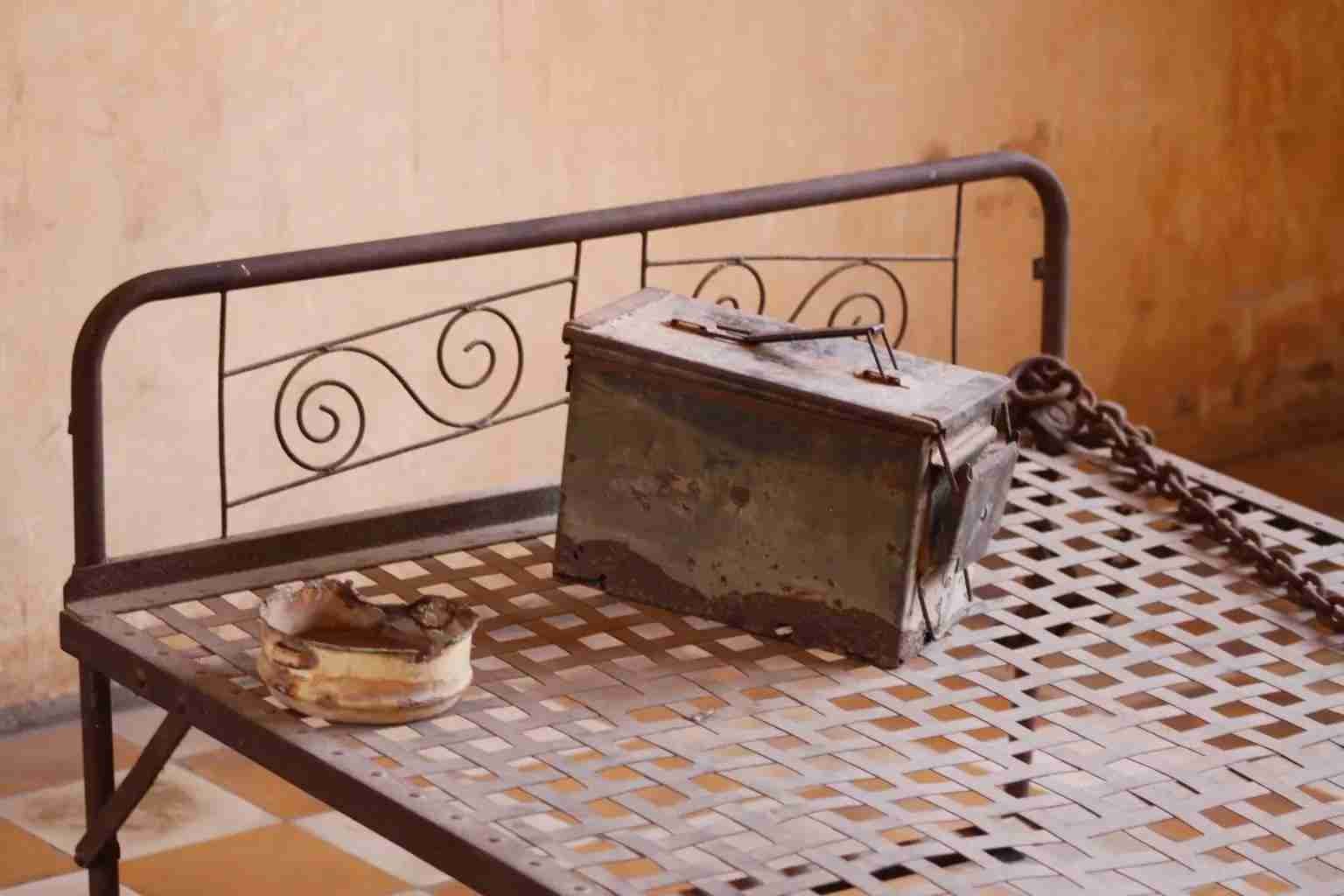
Immediately after occupying Cambodia’s towns, the Khmer Rouge ordered all city dwellers into the countryside to take up agricultural tasks. Under the regime there was no public services, there is no school, no religion, no banknote and no hospital. The Democratic Kampuchea only accepted economic and military aid from its major allies, China and North Korea.
Between 1975 and 1979, The Khmer Rouge regime was responsible for the deaths of millions of Cambodians through forced labour and genocide. From 1979 to 1982, The Khmer Rouge lost control of most Cambodian territory to Vietnamese occupation and survived as a rump state supported by China. In June 1982, the Khmer Rouge formed the Coalition Government of Democratic Kampuchea with two non-communist guerrilla factions, which retained international recognition.
People’s Republic of Kampuchea (1979–93)
On 10 January 1979, after the Vietnamese army and Kampuchean United Front for National Salvation invaded Cambodia and overthrowing the Khmer Rouge, the new People’s Republic of Kampuchea was established with Heng Samrin as head of state.
Pol Pot’s Khmer Rouge forces retreated rapidly to the jungles near the Thai border. The Khmer Rouge and the PRK began a costly struggle that played into the hands of the larger powers China, the United States and the Soviet Union. Civil war displaced many Cambodians, who fled to refugee camps along the border to Thailand and tens of thousands of people were murdered throughout the country.
Peace efforts began in Paris in 1989 under the State of Cambodia, culminating two years later in October 1991 in a comprehensive peace settlement. The United Nations was given a mandate to enforce a ceasefire and deal with refugees and disarmament known as the United Nations Transitional Authority in Cambodia (UNTAC).
Recent Development
The Paris accords and the UN protectorate pushed Cambodia out of its isolation and introduced competitive politics, dormant since the early 1950s. UNTAC sponsored elections for a national assembly in May 1993, and for the first time in Cambodian history a majority of voters rejected an armed, incumbent regime.
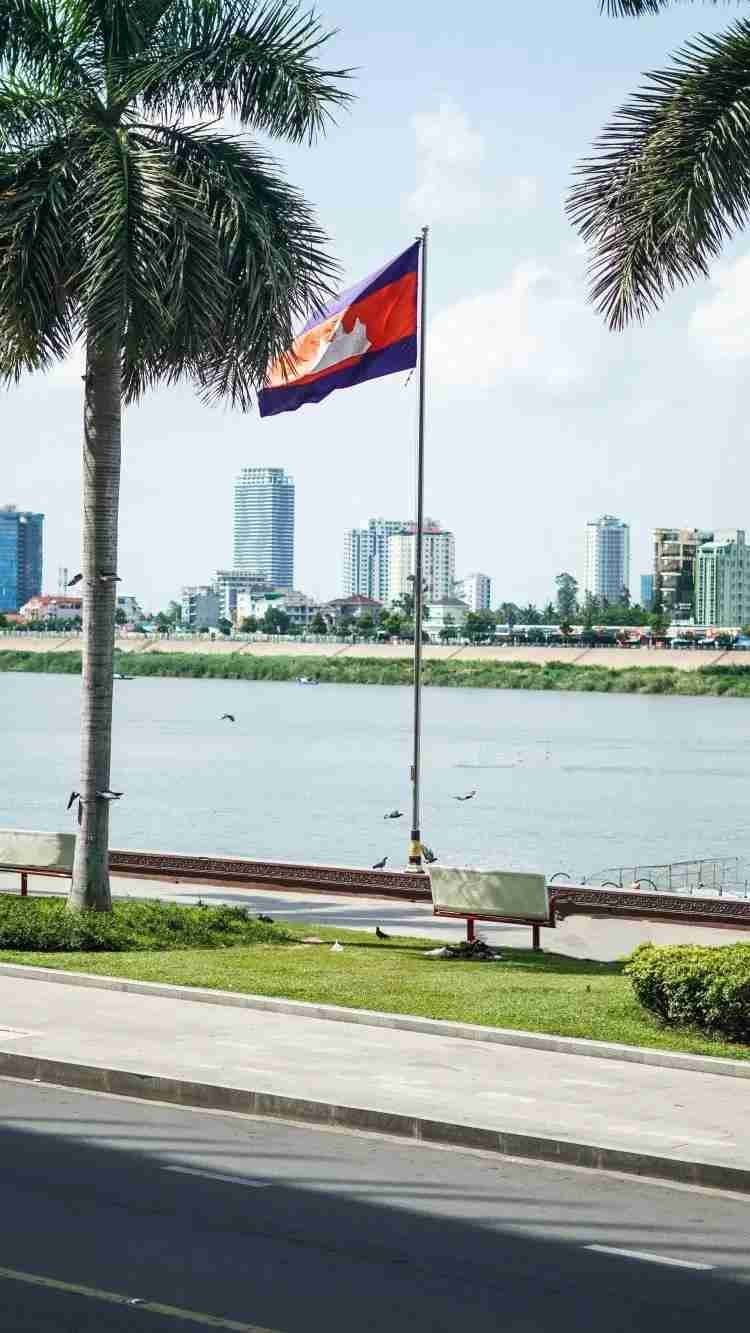
In September 1993 the government ratified a new constitution restoring the monarchy and establishing the Kingdom of Cambodia. Sihanouk became king for the second time. After the 1993 elections, no foreign countries continued to recognize the DK as Cambodia’s legal government. The DK lost its UN seat as well as most of its sources of international aid.
Pol Pot died in 1998, and by early 1999 most of the remaining Khmer Rouge troops and leaders had surrendered. Rebel troops were integrated into the Cambodian army. In 1999 two Khmer Rouge leaders were arrested and charged with genocide for their part in the atrocities.
In the last decade the economy of Cambodia follows an open market system and has seen rapid economic progress. Cambodia had a GDP of $24.57 billion in 2018. Cambodia is establishing a friendly borders with its neighbors, as well as integrating itself into regional (ASEAN) and global (WTO) trading systems.
